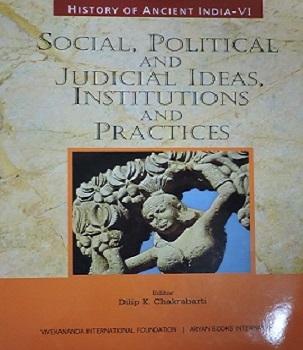History of Ancient India Vol. VI
Social, Political and Judicial Ideas, Institutions and Practices
The Human society offers a vast field of study in any context, and for this volume of essays devoted to the study of ancient Indian society we have selected only a few of its aspects. The first essay is an introduction to the modern anthropological studies on caste whereas the second one is a detailed study of how the ancients perceived the caste differences through time and how the complexity of the system was matched even in the ancient context by some of the complexities that one observes today on the ground. The third essay is basically about the rural and urban contexts in which the caste system operated. It offers a generalized picture of the rural and urban societies of ancient India, giving a spatial and social backdrop to the tangible manifestation of the caste system. The position of the women in ancient Indian society is then discussed by two scholars, one examining mainly the source on which our ideas are based, second offering the theoretical historical frameworks within which the problem has been generally perceived. The sixth essay outlines the basic shapes of the ancient Indian education, state and government, and law. What emerges very clearly is both the logic and stability of the ancient Indian social system with its roots in the concept of Dharma which manifests itself in detail in the Dharmas of the various Varnas and Jatis which have honeycombed this society through the ages.
History of Ancient India Vol. VII
Economy: Agriculture, Crafts and Trade
The present volume on the economic aspects of the ancient Indian history falls into the following clear sections: agriculture, crafts and guilds, trade and trade routes, archaeological data on the trade in the Indian Ocean world in relation to India, and the whole range of the ancient Indian monetary systems and minting techniques.
The first paper on the nature of the literary sources on agriculture up to C.AD 1300 introduces us to an in-depth literary perspective of this crucial economic activity. It is divided into a number of segments, all linked to the basic issue related to agriculture: the question of expansion of agriculture in the post-Gupta period; the types of land and soil fit for cultivation; different ways of adding the manure; actual agricultural processes; various irrigation techniques and systems, and major agriculture implements. The second essay on ‘aspects of agriculture and agricultural tax and land revenue’ complements to some extent the data citied in the first essay. It begins with a section on ‘types of land’ and then passes on to a discussion on land tenures and different aspects of their management and administration. The next two essays deal with the ancient crafts, one in the context of the north and another in the context of the south. Their basic types and the social position of craftsmen have both been taken into account. The problem of guilds, here discussed as comprehensively as possible, is related to the general spectrum of crafts. Trade and trade routes figure on a large scale in the three successive essays after the one on the guilds. The general economic picture has been rounded by a succinct discussion on the corresponding monetary systems.
Publisher: Aryan Books International
Publish Year: 2018










Post new comment